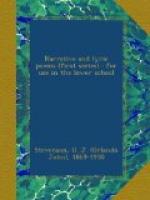[15] sagamore. An Indian chief of the second rank; sachem, a chief of the first rank; pow-wow, a conjurer or medicine-man.
[16] Goldinge. A well-known translator of the Elizabethan age.
[17] The Mayflower set sail for England on April 5, 1621.
[18] Priscilla Mullins (or Molines) was the daughter of William Mullins, who died in the February following the landing of the Pilgrims.
[19]"In his journey, as he was crossing the Alps and passing by a small village of the barbarians with but few inhabitants, and those wretchedly poor, his companions asked the question among themselves by way of mockery if there were any canvassing for offices there; any contention which should be uppermost, or feuds of great men one against another. To which Caesar made answer seriously, ’For my part I had rather be the first man among these fellows, than the second man in Rome.’” Plutarch’s Life of Caesar, A. H. Clough’s translation.
[20] Genesis, ii, 18.
[21] illusion. An illusion is a misleading or deceptive appearance. The happiness that he had looked forward to was turning out to be false and unreal.
[22] Baal and Astaroth were the two chief divinities of the Phoenicians, male and female respectively. To worship Baal and Astaroth is to give oneself up to worldly desires and pleasures.
[23] The Mayflower, in England, is the hawthorn; in the New England States, the trailing arbutus.
[24] Ainsworth. A clergyman and scholar who was persecuted on account of his religious belief, and sought refuge in Holland.
[25] Luke, ix, 62.
[26] Terms used in heraldry.
[27] See Revelation, xxi and xxii. An apocalypse is a revelation, and the term is generally applied to the Book of Revelation.
[28] dulse. Coarse red seaweed, sometimes used as food.
[29] II Samuel, xii, 3.
[30] Districts of the Netherlands.
[31] hand-grenade. A ball or shell filled with explosives, and thrown by the hand.
[32] Wat Tyler. The leader of the peasant revolt in England in 1381.
[33] Elder William Brewster.
[34] See Acts ii, 1-4.
[35] Stephen Hopkins, Richard Warren, Gilbert Winslow.
[36] gunwale. The upper edge of a boat’s side.
[37] thwarts. Seats, crossing from one side of the boat to the other.
[38] adamantine. That cannot be broken; hence fate is “the wall adamantine.”
[39] yards. The spars supporting the sails.
[40] Gurnet. A headland near Plymouth.
[41] The place where the Pilgrims had their first encounter with the Indians, December 8, 1620.
[42] See Genesis, i, 2.
[43] See Genesis, ii, 10-14.
[44] The account of the march of Miles Standish is based on the New England chronicles.
[45] See I Samuel, xvii, and Numbers, xxi.




